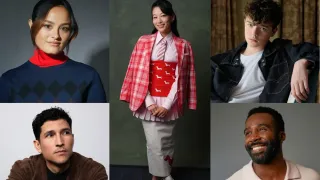June 20, 2014
Think Like A Man Too
Kilian Melloy READ TIME: 2 MIN.
In what figures to be a score for refined palates, the famous 1976 wine tasting in which California selections stunningly triumphed over older French vineyards will be portrayed in the opera “The Judgment of Paris” by composer Jake Heggie.
A rare comedy by Heggie, known best for turning Sister Helen Prejean's “Dead Man Walking” and Herman Melville's “Moby-Dick” into operas, will premiere on July 18 in a production the California's Festival Napa Valley announced Wednesday.
Soprano Danielle De Niese stars as Venus and baritone Quinn Kelsey as Bacchus in a work that mixes mythological gods with the real life people from the event at Paris' Intercontinental Hotel. The cast includes tenor Nicholas Phan as Steven Spurrier, mezzo-soprano Simone McIntosh as Patricia Gallagher and soprano Brenda Rae as Odette Kahn.
“I was looking for something that was fun, delightful, could be kind of wacky and crazy as well as deeply meaningful and cross boundaries,” Heggie said. “One of the judges literally was demanding her scorecards back after the winners were announced. So we’re going to have a nice mad scene for that judge, with Brenda Rae doing coloratura soprano.”
Judges at the wine tasting included Taillevent’s Jean-Claude Vrinat and Le Grand Véfour’s Raymond Oliver. Chateau Montelena’s chardonnay finished first among whites, edging out a Meursault-Charmes Roulot in a comparison of 1973 vintages. Among reds, a 1973 Stag's Leap Wine Cellars' cabernet sauvignon was first, followed by a 1970 Château Mouton Rothschild.
George M. Taber wrote about the tasting for Time magazine and titled a 2005 book “Judgment of Paris,” alluding to a story from Greek mythology describing events leading to the Trojan War.
“It was such a scandal,” Heggie said. “Some of those judges were accused of being traitors by the French.”
Festival CEO Rick Walker called Heggie in January, wanting to create a performance to mark the 250th anniversary of the Declaration of Independence and the 20th anniversary of the annual summer event.
“The outcome, of course, was revolutionary,” Walker said. “It was proof that you can make great wine in the New World in Napa Valley in California and in America but also throughout the New World. It’s not the exclusive province of the Old World.”
Heggie’s operas usually take five to eight years to reach stage. He set to work with his librettist, Gene Scheer, who wrote the text from May through October. Kent Nagano conducts and Jean-Romain Vesperini directs the one-act work of about 60 minutes.
Excerpts will be played at the French department store Printemps in New York on Feb. 18 and there will be workshop at the San Francisco Conservatory of Music in April followed by more snippets in Los Angeles on May 26.
“Opera historically has bloomed out of myths and mythology and to lean into that as a point of departure seemed sort of natural,” Scheer said. “When you’re doing a comedy, when the stakes are high and the egos are high or grand, it makes it easier to make fun of them and have fun with it.”






